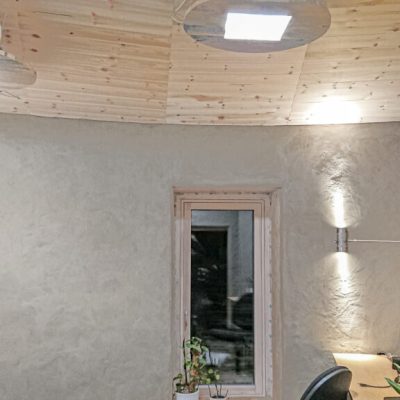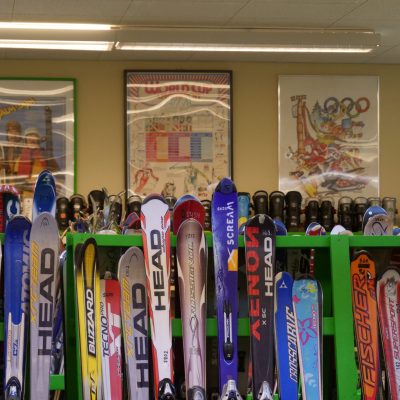Madaster
Web :
Contact :
info@madaster.com
Localisation : Netherlands, Switzerland, Germany, Belgium, Norway, Austria
Date of meeting : 20 april 2023
Maturity of the projet : Mature
- Eco-design
- Recycling
- Digitalization
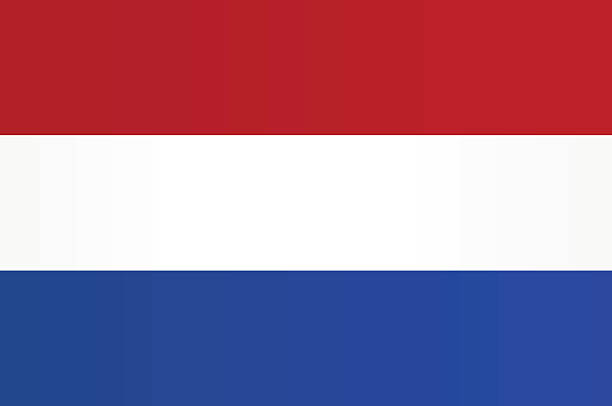
Eliminate waste from the construction sector
Created six years ago, Madaster is an international scale-up steering the construction sector towards a circular economy. Their purpose is to eliminate waste from the construction sector through digitalization and with the spreading of a new concept : the material passport.
Born in the Netherlands, currently active in 5 further countries – Switzerland, Germany, Belgium, Norway and Austria – and growing, they are at the forefront of the transition toward a circular economy in one of the most waste-intensive industry sectors.
We had the chance to meet Martijn Oostenrijk, one of the co-founder of Madaster and now managing director of the company.
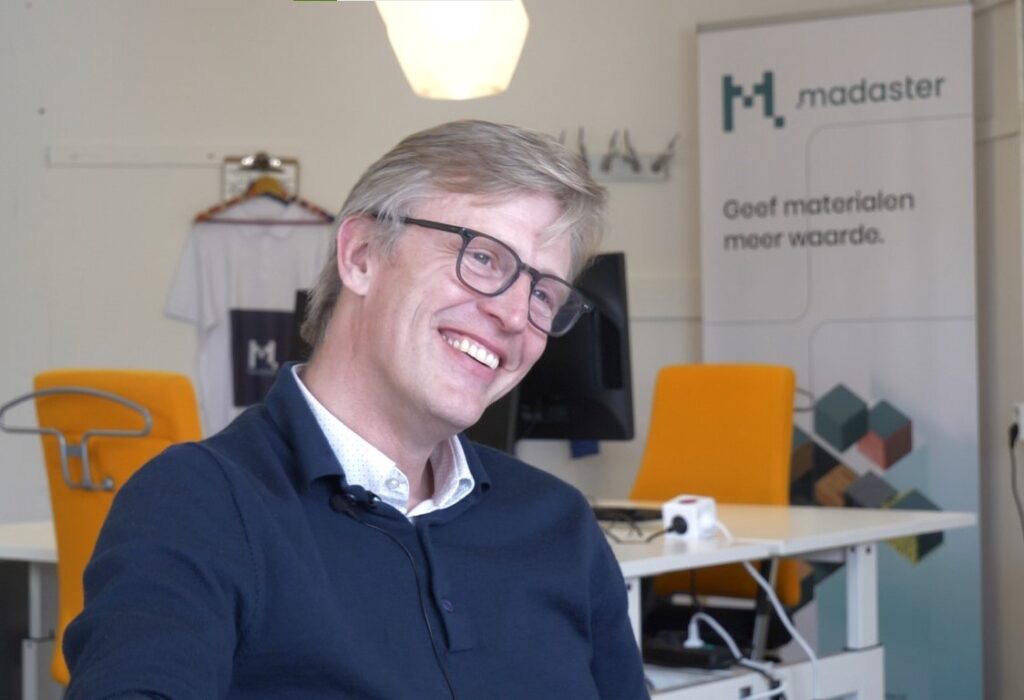
The construction sector : CO2-, resource- & waste-intensive
The construction sector creates more than 247 millions of tons of waste each year in France, making this sector responsible for more than 70% of all waste generated [1]. In the Netherlands, Martijn explains that this statement is not much different : in the linear system, with a take-make-waste point of view, 40% of the materials end up as degenerated stuff and lost for future use. Moreover, carbon dioxide emissions linked to the construction sector reached 10 Gt in 2021, for a global total of 37 Gt : almost a third of all global emissions [2].
Those numbers make it clear that the construction sector really is a big part of the climate and waste issues. However it is not new information that the building industry is not the greener one, so why is it still so ?

For Martijn, it is mainly due to the construction sector being very conservative and late in the digital transformation, in combination with the fact that finance still rules our world and financial people don’t understand that materials are valuable in essence.
Facing those challenges, Thomas Rau, a pioneering Dutch architect and author of the book “Material Matters”, approached Martijn Oostenrijk and Pablo van den Bosch, then working in the finance industry, to help him explain that circularity comes with financial benefits and value : Madaster was born.
Image source : RAU, Triodos Bank
“Ok this makes a difference, this is important, this is urgent and here we can make change”
What is Madaster ?
Madaster is an online platform, and like the land register, one can register all materials and products in their built environment, whether it is real estate or infrastructures. Once those materials are registered, they are provided with an identity. In the end, the aim is to extend this platform at a major scale so that it could be able to register any objects anywhere in the world.
“Giving them an identity means that we can make conscious decisions about their future use instead of degrading those materials into a waste stream.”
The importance of digitalization
The construction sector has certain industry standards all architects, construction companies and engineers work with. Among those standards is something called the Building Information Management or BIM, that is the digitalization of a building. It contains all the different materials and products that are assembled in the product.

Along with that is the Environmental Product Declaration (EPD) : defined by the ISO, it enables each company producing a product to quantify environmental information on the life cycle of this product to enable comparisons between products fulfilling the same function. Each year, legislation increases the demand for such declarations.
Hence, combining the BIM where “everything you can imagine in a building is captured” with the EPD of the products inside the building, enriching it with all kinds of environmental and financial data from trustworthy sources, Madaster creates many precious environmental and financial indicators for their clients, such as circularity index, detachability, embodied carbon or financial residual value.
The circularity index
Based on the Ellen Mc Arthur methodology, the circularity index is constructed based on three stages : the development stage, the use stage and the end-of-life stage.
Within those tree stages, if more existing materials are used instead of virgin, that’s a plus in the development stage ; if the construction and the materials used during the construction phase lead up to a longer lifespan than the average, then that’s a plus, and if it was constructed in a way that it can be detached from the building for reuse, that’s a plus. The combination of those three stages leads to a circularity index between 0 and 100 and the score is penalized if information is missing.
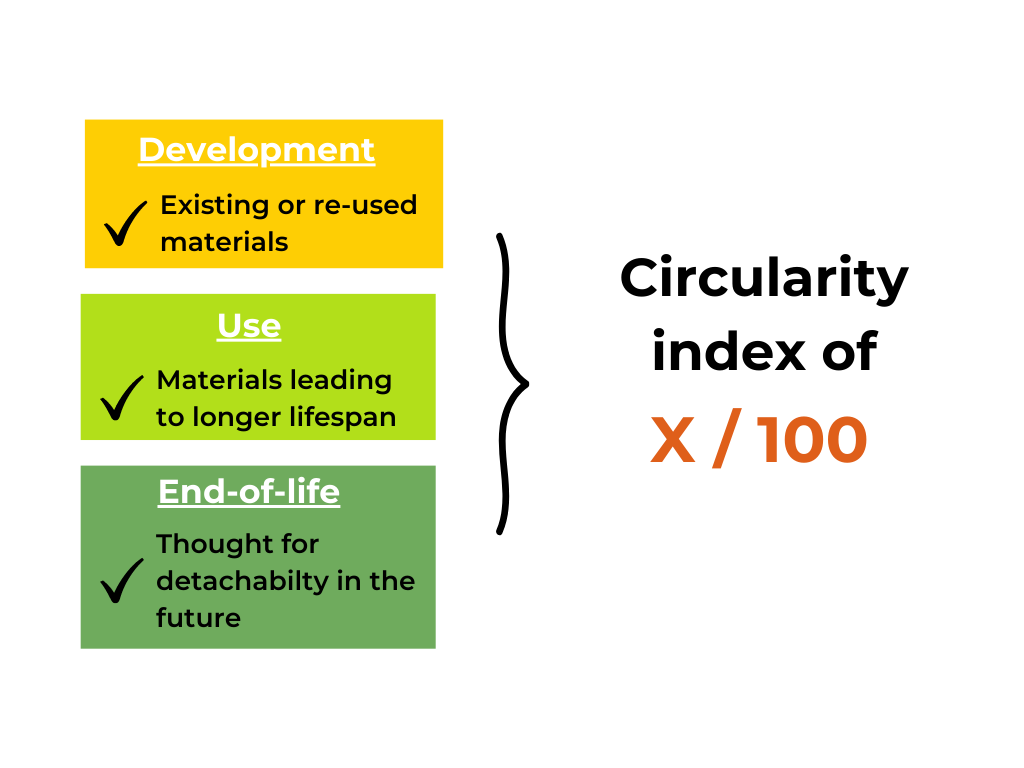
The financial residual value
It is the value of a building at the end of its life : what materials can be reused, what’s the cost of reusing these materials ?
Current and historical prices of each material in the building have been looked upon to create a line toward and guess their price in the future. Then, deducting the cost of removing, transporting and processing these materials for reuse, we can have the real financial residual value of a building. If materials are assembled in a way that they are easily detachable, it will lower the cost of processing it and increase the financial residual value of a building.
“When we calculate the residual value of materials in a building, we want it to be really high because that incentify the user to get that steel bar out and sell it for reuse.”
Whom is Madaster made for ?
As a self-service platform, everyone can start working with Madaster simply by registering to an annual subscription : 900 €/year for businesses and 20€/year for private persons.
The entire value chain of construction is invited to use Madaster. From the asset owners (governmental body, major investor, house owners) to the building team and finally the accelerators such as banks, insurance companies and so on. The latter will see its interest by the transparency brought with Madaster : full transparency on your materials leads to lower risks and the knowledge on what the building really is worth.
Across the 6 countries covered by Madaster, over a 1 000 different entities are using the platform and that makes a total of 4 000 active users. Furthermore, over 5 000 objects have been registered and the 30 millions m² of registered area has been crossed recently.
Why should we use Madaster ?
For Martijn, there are three main reasons explaining why we should use Madaster.
The first is the environment : quite simply, using the right materials (sustainably sourced, re-used…) assembled the right way (for detachability) will lead to less environmental impacts.
“Madaster allows the users to make those choices at the right moment in time before it’s being built.”
If environmental and circular aspects are part of the discussion from the start, it will have huge benefits, as examples, on the health of the tenants or the employees in the building and on lowering the risks, hence ensuring better safety.
The second is compliance. Seeing the EU legislations strengthening, meeting those regulations as it’s not yet mandatory is of huge importance to give you a mandate to continue as such. Not being compliant comes with the cost of repairing your actions, hence it’s easier to do it from the start.
Finally, the last but one of the most important for asset owners, finance. Having an eco-friendly building and meeting regulations comes with higher occupancy rates, higher building value, discount on financing : it’s a 100 % worth the investment.
Indeed, with Madaster, the client can see what their building is worth at the moment and try to improve it, environmentally or financially speaking. If they want a better score in circularity or embodied carbon, then the platform provides suggestions to reach that : environmental-friendly materials, better designs, more equipped for reuse at the end of life…
Why is it important to give materials an identity ?
“We regard waste as materials without an identity. Madaster provides materials with an identity. The whole purpose of doing that is that we can connect these materials to future reuse scenarios. The challenge is to capture all those materials at a huge scale and to make all this information transparent to those who are initiating new developments, so that they can harvest the materials who now have an identity. So we’re connecting the old world to the new world.”
Existing buildings are called material mines because they were not created to be deconstructed so you have to dig into them to extract and process what you want. New building can be constructed as a material depot, knowing exactly where materials are, in what shape and form, so as to reuse them best.
Madaster has some impressive use-cases with 90% of materials being reused thanks to the materials passport when a renovation was done.
“There’s a lot of valuable diamonds in the mine and we want to rescue them and give them a safe future.”
What’s the future of the construction sector ?
One of the main challenges of Madaster is that the construction sector is quite conservative and spends very little of their budget on digitalization.
That’s why, for Martijn, governments are playing a crucial role in all of this because it’s really hard to change such a competitive market with existing rules that are the opposite of circular ; demolishing is, at first sight, way cheaper than reusing materials. For him, some steps are taken, especially at the EU level, but there’s a lot more needed in order to fuel that transition on a local level.
“I truly believe that governments will ultimately say “You have to create a material passport” because of all the societal benefits around that.”
However, in the Netherlands, it is now mandatory since the 1st of January 2023 for all governmental bodies to include environmental and circularity aspects in their tendering. Hence, in any request to the market, these aspects are part of the information they have to apprehend before accepting a new supplier. Moreover, in Germany, a material passport is now mandatory [3].

